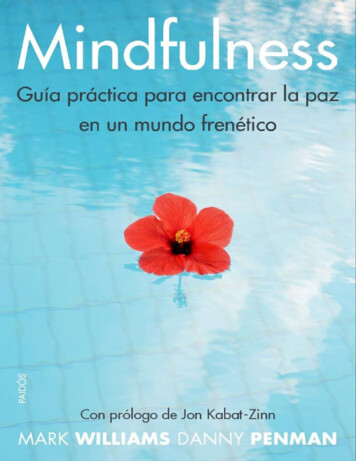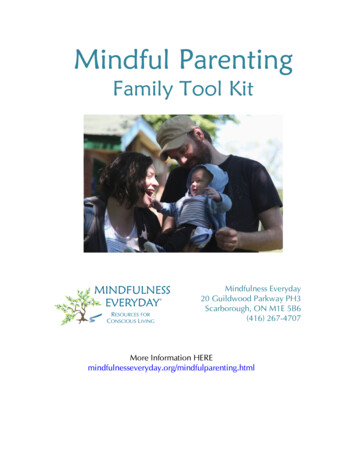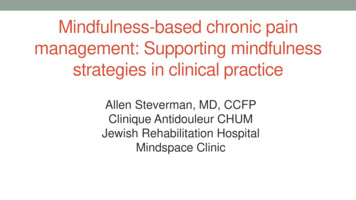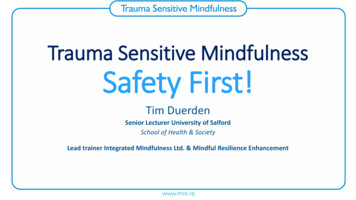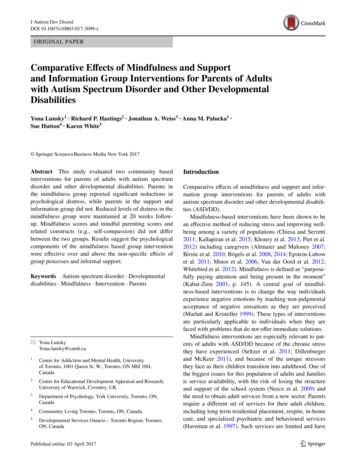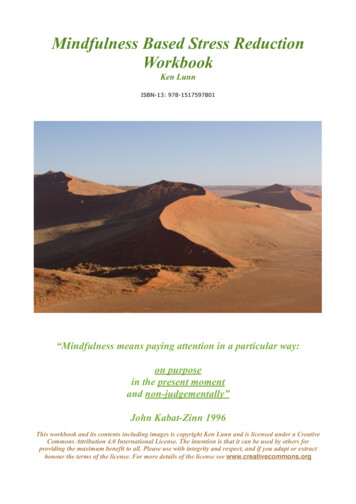
Transcription
WelcomeHow Mindfulness CanSupport the Therapist,Enhance the TherapeuticProcess, and EncourageChange in the Client.
“Mindfulness itself cannot be capturedin a technique. It is a way ofbeing Waking up to our lives ineach moment requires intention andeffort. It is an endeavor that weundertake for ourselves, and canshare with our patients, usingwhatever means at our disposal.”Germer, Siegel and Fulton, Mindfulness and Psychotherapy
What is Mindfulness? Giving intentional, nonjudgmental attentionto our experience in the here and now. Is very simple, yet so counter to our mind’shabits, what our culture encourages andwhat we do to stay safe or comfortable. Learning to stay present creates awarenessthat allows us to CHOOSE how to respond. Mindfulness Awareness choice.
Important Aspects ofMindfulness Approach is non-judgmental – accepting - curious.Judgement stops the ability to learn/choose. Learning to “Let go” or “let be” v.s. “fixing”. It’s purposeful –“training” a busy, distracted mind. It is an EMBODIED practice, not just “in our head”. We start to see our patterns and the negativeeffects of our attempts to avoid. (fix, blame orcriticize)
Working with our Thoughts“Awareness v.s. Content” Becoming aware of what we are thinking - createsseparation from and perspective on our thoughts –do not feel so overwhelmed or controlled by them. Like developing an “observing ego/observing self”– becoming a “participant observer”. IMAGE: We are the sun, our thoughts are likeclouds. Clouds are not the sun, they obscure thesun.
“Pain is Inevitable .Suffering is Optional”(Pain Resistance Suffering) Being human is difficult. We are all imperfect.There is much we don’t control. HOW we deal with difficulty is what we have controlover. Our resistance can create more suffering. How do we develop wise and compassionateresponses to the difficulty in our life?
Self Compassion“The Missing Ingredient” Self compassion is a learnable skill, responding to ourown suffering in a kind way builds resilience. Often there is misunderstanding about and resistanceto self compassion. We tend to fix, blame, ignore ordeny,Three components of Mindful Self-Compassion:Mindfulness/Common Humanity/Kindness
Mindfulness in Psychotherapy Focus is on the present moment and learning skills. We are not “self improvement projects”- we havewhat we need – we start where we are. Change occurs through acceptance and turningtoward difficulty. Healing does NOT mean doing away withsymptoms. Be aware of bias and social location.
How Mindfulness Helps theTherapist Improves focus and cognitive flexibility. Increases our ability to abide with difficultemotions in session and not carry them with usafter session. (TONGLEN) Sharpens our awareness of our own reactivity,counter-transference, secondary trauma. Quiets our mind, renews our energy, Protectsagainst burn-out and fatigue.
How Mindfulness Enhancesthe TherapeuticRelationship Deepens our capacity for compassionate andnonjudgmental presence, client “feels felt”. Increases credibility, trust and authenticity. (Wehave done what we are asking them to do.) Increases skill in using our own experience intherapeutic interventions.
How MindfulnessHelps the Client Increases affect regulation and tolerance (increases theirability to stay present to difficult emotions) Develops an observing ego (increased awareness of reactions“in the moment” ) Increases ability to change emotional states and self-soothe(“training” the mind / tools for calming, grounding, soothing) Alters negative core beliefs/schemas/working models(reduces negative automatic thoughts and “story lines”) Supports healing of traumatic wounding and shame(deepens compassion for self and others, reduces feelings ofisolation)11
Trauma InformedMindfulness Understand trauma - including ACE’s and theeffects of neglect, abuse and oppression. Intentionally engaging in “being present” cantrigger thoughts, feeling and bodily sensations ofunresolved or undiscovered issues and trauma. TITRATE: shorter, well-structured and supported.Client is in control of the process. Include practices for resourcing: grounding in thesenses, orienting oneself, calming self-talk,soothing self touch, moving the body.
When MindfulnessMay Be Contra-indicatedWhen a client: Has traumatic memories or flash backs that are toostrong Feels overwhelmed or harmed by their innerexperience Has “introjected voices” that are too harsh or unrelenting Fears possible disintegration or loss of sense of self Is in a state of acute grief or deep clinical depression Experiences breaks with reality-psychosis ordisassociation Wants to use meditation for “spiritual bypassing”13
Integration of MindfulnessImplicit to Explicit Therapist explores mindfulness information, underlying principlesTherapist’s approach to therapy is influenced bymindfulnessTherapist works with clients using mindfulnesstechniquesTherapist teaches meditative practiceand explicitly discusses topics ofmindfulness and meditation in session
Incorporating Mindfulness intoYour Sessions Pause together at beginning of session. Encourage client to: come back to the presentmoment, (Sacred Pause) sense it in their body,notice common patterns/beliefs. Include brain/neuroscience information. Help client see their thoughts/feelings as separatefrom themselves and changeable. Teach skills to tolerate being present whenuncomfortable. Self compassion, self soothing,breathing, grounding, affect tolerance (DBT, ACT)
Between Sessions /“Homework” Ask client to take moments to pause and noticewhat they are thinking and feeling. Explore exercises/practices from MSC, DBT, or ACT. Engage in breathing, grounding or self soothingtechniques that they have practiced in session. If they are interested, encourage practices (thatyou have done): meditation, gratitude, lovingkindness, yoga (Short, guided, perhaps withincommunity). Read supportive books/articles. (Tara Brach, PemaChodron, Rick Hanson)
Resources: BOOKS Mindfulness and Psychotherapy: Edited Germer, Siegel, &Fulton Sitting Together; Essential Skills for Mindfulness-BasedPsychotherapy, Pollack ,Pedulla, and Siegel Self Compassion in Psychotherapy. Germer and Siegel The Mindful Way Through Depression: Williams, Teasdale . Self Compassion: Kristen Neff The Mindful Path to Self-Compassion: Chris Germer The Buddha’s Brain: Rick Hanson Trauma-Sensitive Mindfulness: David Treleaven. WORKBOOKS:DBT, Dialectical Behavior Therapy; ACT,Acceptance and Commitment Therapy and MSC Mindful SelfCompassion
Resources for You and Your Clients Apps: Insight Timer, 10% happier, Headspace,Calm Websites/You Tubes/Books for clients: Tara Brach,Pema Chodron, Rick Hanson, Jack Kornfield. Richard Davidson, Dan Siegel, Guided Imagery & Meditations: Health Journeys Workbooks: DBT, ACT, Mindful Self Compassion IFOT Indigenous Focusing-Oriented Therapy, Loveand Rage, My Grandmother’s Hands https://dialecticalbehaviortherapy.com (DBT) https://positivepsychology.com/act-worksheets
Thank you for your kindattention.Jane Rauenhorst Ph.D., L.P.Contact Information:jane.rauenhorst@gmail.com651-757-0708
Tara Brach, Pema Chodron, Rick Hanson, Jack Kornfield. Richard Davidson, Dan Siegel, Guided Imagery & Meditations: Health Journeys Workbooks: DBT, ACT, Mindful Self Compassion IFOT Indigenous Focusing-Oriented Therapy, Love and Rage, My Grandmother's Hands https://dialecticalbehaviortherapy.com (DBT)



